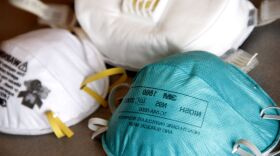When toxic chemicals are released into the environment, figuring out whether they’re making people sick can be a major challenge. It’s a problem the state is trying to solve now in the Sawmill and Wells Park neighborhoods near downtown Albuquerque, where an underground plume of dangerous dry cleaning solvents is flowing just beneath people’s homes and businesses.
A few months ago, state environment department workers knocked on Andrew Benavidez’s door in the Sawmill neighborhood. He was less than enthusiastic when they asked to test his house for fumes wafting up from a nearby groundwater plume of cancer-causing chemicals.
"I don’t want the government on my property at all," he said. "There’s really nobody that should be messing around and poking in this area."
Benavidez’s answer to the state’s request was a resounding “no.”
"My grandma’s been living here since she was little, and her grandparents, so nothing’s wrong with the water here I don’t think," he said.
That’s not what NMED was hoping to hear. Benavidez lives in one of 14 homes the state has been trying to test as part of an investigation into the plume, which leaked into the groundwater decades ago from a chemical distribution business called Laun-Dry Supply Co.
Only three people have agreed to have their homes tested, and so far only one turned up positive for airborne chemicals at very low levels that didn’t pose a health risk.
That’s certainly good news. But does it mean that the plume isn’t a danger to the neighborhood? KUNM tried to ask NMED about that, but spokeswoman Allison Majure is blocking us from speaking with NMED staff about the issue.
But Dr. Ann Aschengrau of the Boston University School of Public Health doesn’t mince words. She’s an epidemiologist who researches exposure to TCE, the main chemical in the Laun-Dry plume. She said testing three out of 14 houses for a plume of this size is "grossly inadequate."
"I don’t even know if the 14 would be enough," she said.
That's because tracking down where chemicals in the groundwater are coming to the surface is really, really hard to do. Toxic fumes can move through cracks and cable lines underground, even get into sewer pipes and poison the air in people’s homes that way.
Bottom line, Aschengrau said: NMED needs to do more tests in more buildings. And that’s a point the department’s Groundwater Bureau Chief Michelle Hunter agrees with. Here she is speaking at a Wells Park Neighborhood Association Meeting in June.
"We agree, three samples is not enough," Hunter said, "but when you knock on 20 doors and only three people sign up, that’s all you get."
Hunter has been overseeing the effort to test buildings for chemical gas from the plume.
"It can be a hard sell," she explained. "And people can fear for their property values, which, I totally get that, but it’s something that I would want to know.”
But even though the Environment Department hasn’t had much luck getting permission to test the 14 houses closest to the plume, lots of other people living nearby are anxious to get their homes tested.
"Within our block there’s been folks who died of brain cancer and then a brain tumor," said Bianca Encinias, who was pregnant when she moved into her home in Wells Park, just a few blocks from the plume.
"I know that one of my children has early developmental problems, and I never would have thought that living close... I didn’t even know that we lived by a plume," Encinias said.
Connecting the dots between any illness and long-term environmental pollution can be almost impossible. That’s especially true in cases like this one, where the contamination has been there for at least 20 years.
Dr. Aschengrau from Boston University said those kinds of questions—scary though they may be—can’t really be answered at this point.
"You just don’t know what’s happened in the past," she said. "Say someone in one of these neighborhoods develops cancer. Can they really say that it’s from this exposure? They can’t really."
Aschengrau said the important thing now is to make sure nobody is getting exposed to toxins from the Laun-Dry plume, and to get the contamination cleaned up. That should start happening soon.
Laun-Dry is now submitting its cleanup plan for the state to review, and in the meantime the Environment Department is planning to do more testing in homes and businesses.
Victoria Edwards contributed to this report.
*****
KUNM’s Public Health New Mexico project is funded by the W.K. Kellogg Foundation, theCon Alma Health Foundation and the McCune Charitable Foundation. Find out more at publichealthnm.org.






